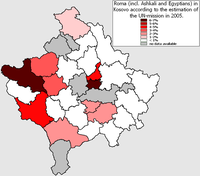
The Kosovo War, was an armed conflict in Kosovo that lasted from 28 February 1998 until 11 June 1999. It was fought between the forces of the Federal Republic of Yugoslavia, which controlled Kosovo before the war, and the Kosovo Albanian separatist militia known as the Kosovo Liberation Army (KLA). The conflict ended when the North Atlantic Treaty Organization (NATO) intervened by beginning air strikes in March 1999 which resulted in Yugoslav forces withdrawing from Kosovo.
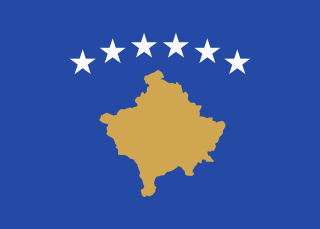
Kosovo, officially the Republic of Kosovo, is a country in Southeast Europe with partial diplomatic recognition. Kosovo lies landlocked in the centre of the Balkans, bordered by Serbia to the north and east, North Macedonia to the southeast, Albania to the southwest, and Montenegro to the west. Most of central Kosovo is dominated by the vast plains and fields of Metohija and the Kosovo field. The Accursed Mountains and Šar Mountains rise in the southwest and southeast, respectively. Its capital and largest city is Pristina.

The Kosovo Liberation Army was an ethnic Albanian separatist militia that sought the separation of Kosovo, the vast majority of which is inhabited by Albanians, from the Federal Republic of Yugoslavia (FRY) and Serbia during the 1990s. Albanian nationalism was a central tenet of the KLA and many in its ranks supported the creation of a Greater Albania, which would encompass all Albanians in the Balkans, stressing Albanian culture, ethnicity and nation.
This article includes information on the demographic history of Kosovo.

Gjakova is the seventh largest city of Kosovo and seat of Gjakova Municipality and Gjakova District. The city has 40,827 inhabitants, while the municipality has 94,556 inhabitants.

The Kosovo Force (KFOR) is a NATO-led international peacekeeping force in Kosovo. Its operations are gradually reducing until Kosovo's Security Force, established in 2009, becomes self-sufficient.
The Ashkali, otherwise known as Hashkali and/or Balkan Egyptians, are Albanian-speaking Muslim ethnic cultural minorities, which mainly inhabit Kosovo and southern Serbia, as well as Albania, Montenegro, and North Macedonia. Prior to the Kosovo War of 1999, the Balkan Egyptians or Ashkali people registered themselves as Albanians. While some Ashkali speak Romani language, Egyptians usually do not. The two groups are not clearly delineated. On the other hand, they differ linguistically and culturally from the Roma, even though they have often been grouped together under the acronym RAE.
In 2008 there were about 500-700 Romani people in Mitrovica refugee camps. These three camps were created by the UN in Kosovo. The camps are based around disused heavy metals mines which have fallen out of use since the end of the Kosovo War of 1999. There have been complaints that the residents are suffering severe lead poisoning. According to a 2010 Human Rights Watch, Romani displaced from the Romani quarter in Mitrovica, due to its destruction in 2000, continued to be inmates of camps in north Mitrovica, where they were exposed to environmental lead poisoning.
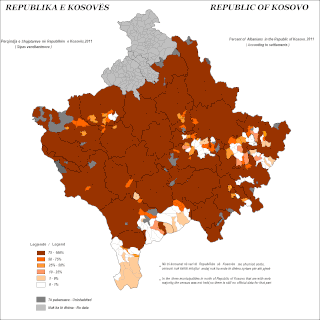
The Albanians of Kosovo, also commonly called Kosovo Albanians, Kosovan Albanians or Kosovars, constitute the largest ethnic group in Kosovo.
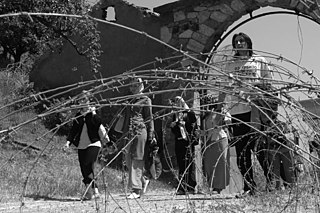
On 17–18 March 2004, violence erupted in the partitioned town of Mitrovica, Kosovo, leaving hundreds wounded and at least 14 people dead. The unrest was precipitated by reports in the Kosovo Albanian media which claimed that three Kosovo Albanian boys had drowned after being chased into the Ibar River by a group of Kosovo Serbs. UN peacekeepers and NATO troops scrambled to contain a raging gun battle between Serbs and Albanians. Serbs call the event the March Pogrom, while the Albanians call it the March Unrest.

Kosovo Serbs are one of the ethnic groups of Kosovo and they form the largest ethnic minority community in Kosovo (5–6%). There are around 100,000 Kosovo Serbs as of 2014 and about half of them live in North Kosovo. Other Kosovo Serb communities live in the Southern municipalities of Kosovo.

Muslim Romani people are people who are ethnically Roma and profess Islam. There are many different Roma groups and subgroups that predominantly practice Islam, as well as individual Romani people from other subethnic groups who have accepted Islam. Xoraxane Roma in Balkan Romani language, are non-Vlax Romani people, who adopted Sunni Islam of the Hanafi madhhab at the time of the Ottoman Empire. Some of them are Derviş of Sufism belief, and the biggest Tariqa of Jerrahi is located at the largest Arlije and Gurbeti Muslim Roma settlement in Europe in Šuto Orizari, locally called Shutka in North Macedonia have their own Romani Imam and the Muslim Roma in Šuto Orizari use the Quran in Balkan Romani language. Many Romanlar in Turkey, are members of the Hindiler Tekkesi a Qadiriyya-Tariqa, founded in 1738 by the Indian Muslim Sheykh Seyfullah Efendi El Hindi in Selamsız. Roma Muslims in Turkey and the Balkans are mostly cultural Muslims or nominal Muslims.

Religion in Kosovo is separated from the state. The Constitution establishes Kosovo as a secular state that is neutral in matters of religious beliefs and where everyone is equal before the law and freedom to belief, conscience and religion is guaranteed.

Numerous war crimes were committed by all sides during the Kosovo War, which lasted from 28 February 1998 until 11 June 1999. According to Human Rights Watch, the vast majority of abuses were attributable to the government of Slobodan Milošević, mainly perpetrated by the Serbian police, the Yugoslav army, and Serb paramilitary units. During the war, regime forces killed between 7,000–9,000 Kosovar Albanians, engaged in countless acts of rape, destroyed entire villages, and displaced nearly one million people. The Kosovo Liberation Army has also been implicated in atrocities, such as kidnappings and summary executions of civilians. Moreover, the NATO bombing campaign has been harshly criticized by human rights organizations and the Serbian government for causing roughly 500 civilian casualties.
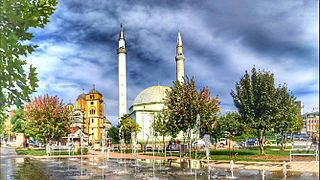
Ferizaj or Uroševac, is a city and a municipality in Kosovo. It is the sixth largest city in Kosovo by population and also the seat of Ferizaj Municipality and the Ferizaj District.

Deçan Municipality or Dečani Municipality is a municipality located in the District of Gjakova of Kosovo. The seat is the town of Deçan. According to the 2011 census, the municipality has 40,019 inhabitants, with 3,803 inhabitants in the town of Deçan.

The Kosovo Agency of Statistics monitors various demographic features of the population of Kosovo, such as population density, ethnicity, education level, health of the populace, economic status, religious affiliations and other aspects of the population. Censuses, normally conducted at ten-year intervals, record the demographic characteristics of the population. According to the first census conducted after the 2008 declaration of independence in 2011, the permanent population of Kosovo had reached 1,810,366.

The 2000 unrest in Kosovo was the result of the United Nations Interim Administration adopting Resolution 1244 on 10 June 1999. The unrest was fought between the Kosovo Force (KFOR), Kosovo Albanians, and Kosovo Serbs. It lasted somewhere from February 16, 2000 – June 6, 2000. An unknown number of Kosovo Albanians and Kosovo Serbs died along with an unknown number injured, while 1 Russian KFOR soldier died from shot wounds and UNMIK vehicles were burned during the unrest.

The attack on Orahovac was a 3-day long clash Between 17 and 20 July 1998 and was fought between the forces of the Kosovo Liberation Army (KLA) and the FR Yugoslavia. The KLA surrounded Serb villages intending to assert authority for the Kosovo Albanian provisional government through taking over a town and creating a corridor between KLA hotbed in Drenica and the Albanian border region. 8 KLA fighters and two Yugoslav police officers were killed, as well as five Serb civilians during the attack, while 85 Serb civilians were abducted by the KLA, 40 of whom are presumed to have been murdered. During the takeover of the town by Serbian special police, 79 Albanians civilians were executed.
Fehmi Vula is a medical doctor and politician in Kosovo. His arrest and detention by Serbian authorities in 1998 were reported by international human rights organizations. Vula served in the Assembly of Kosovo from 2004 to 2007 as a member of the Democratic League of Kosovo (LDK).
